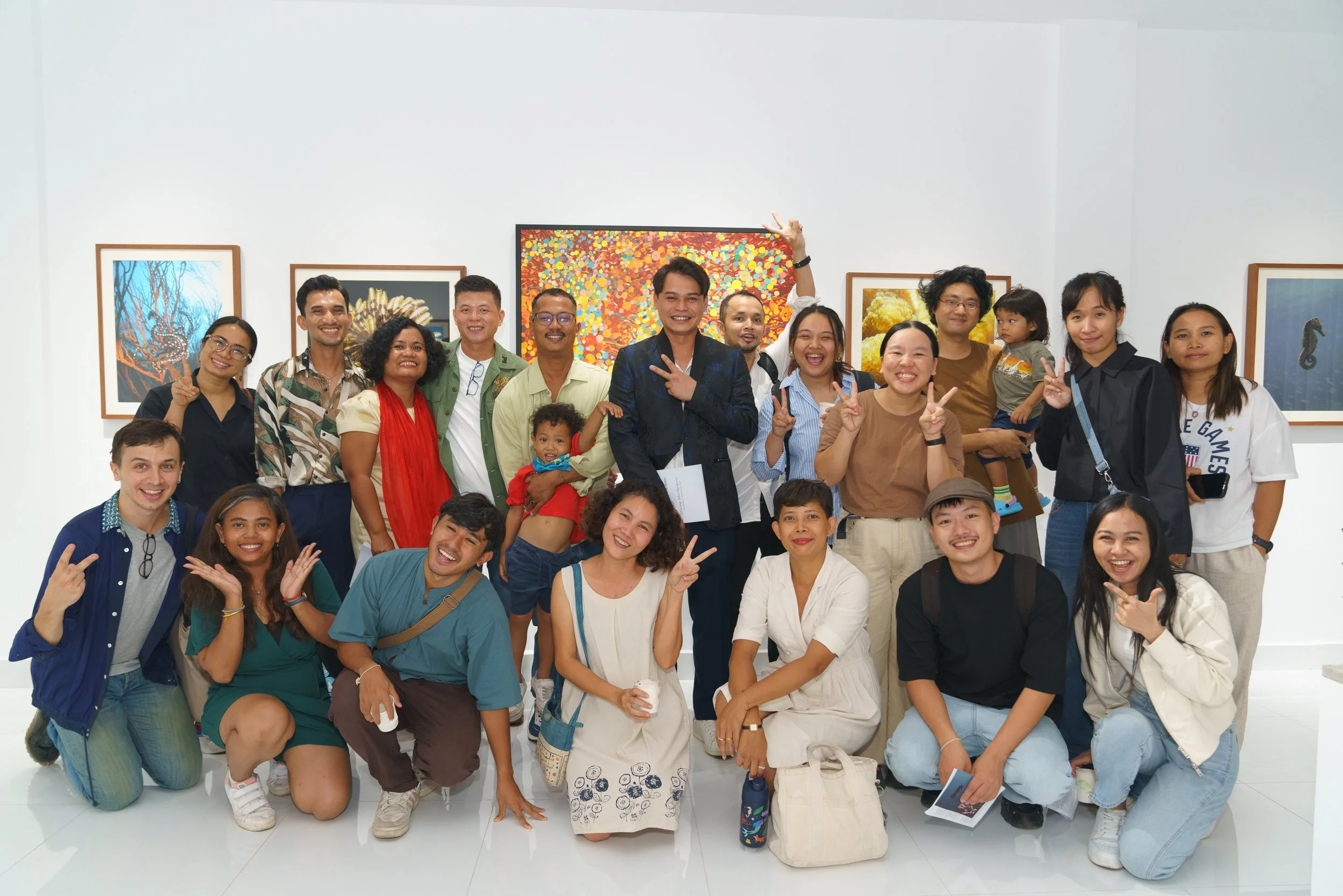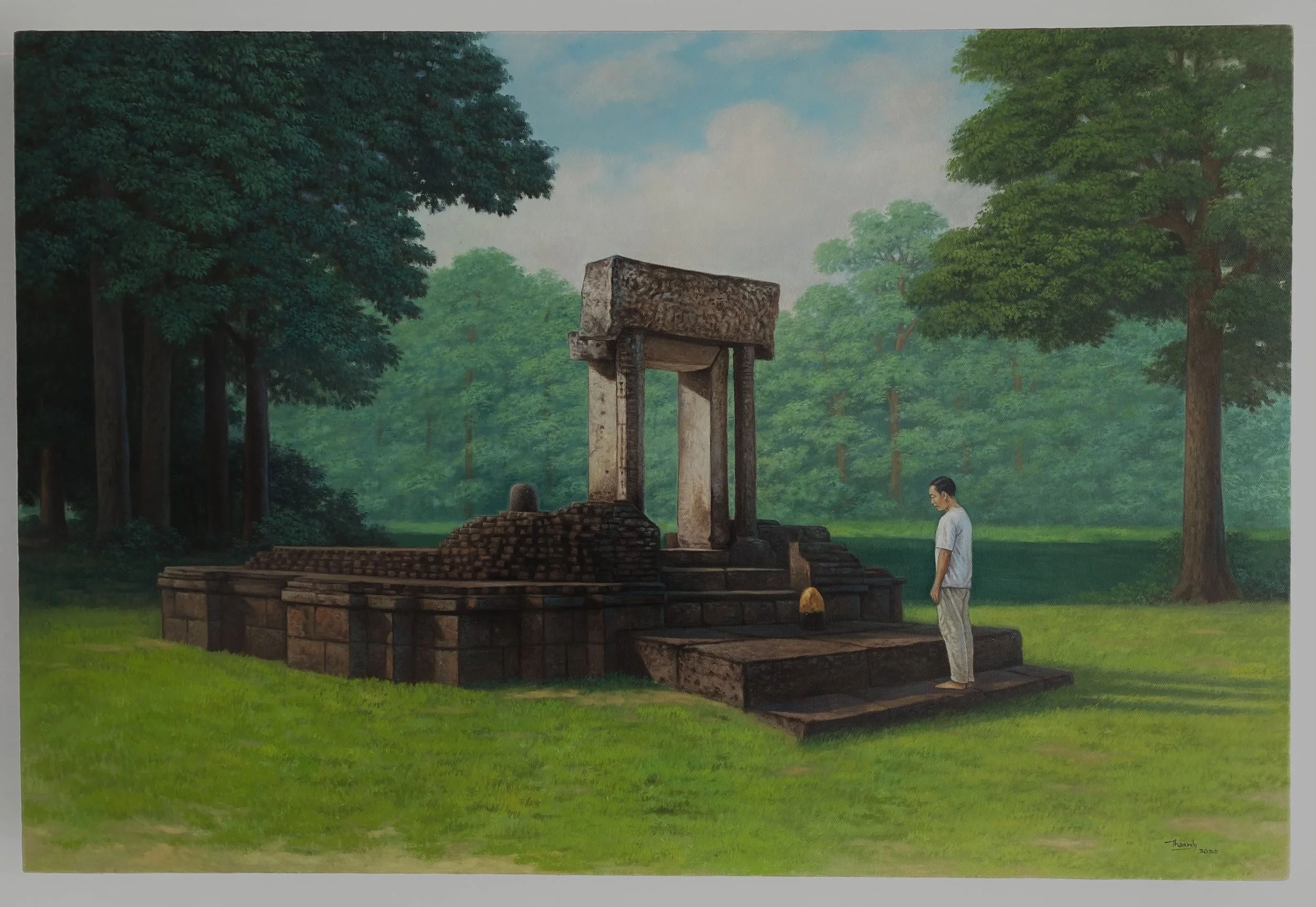Conversation with Chum Chanveasna
Founder of SNA Arts Management
This article is a part of CHECK-IN 2025, our annual publication. You can purchase the physical edition (with access to the digital copy) for SGD38, or the digital copy for SGD5 here.
My Own Words is a monthly series which features personal essays by practitioners in the Southeast Asian art community. They deliberate on their locality's present circumstances, articulating observations and challenges in their respective roles.
SNA Arts Management (SAM) is a gallery and art agency in Phnom Penh connecting Cambodian artists with local and international platforms. Founded in 2024 by Chum Chanveasna, who is also known as Sna, SAM is part of a wider movement to sustain and evolve Cambodia’s contemporary art scene after the closure of influential spaces such as Sa Sa Bassac and Sa Sa Art Projects. In this interview, Sna reflects on her deep family ties to the arts, her experience across different organisations, and her vision for ecosystem building in Cambodia.
Group photograph from the inaugural exhibition at SNA Arts Management, Immersed in Land and Water (2024). Sna is in the back row, third from left. Image courtesy of SNA Arts Management.
You mention that your family has been involved in the arts across generations. Could you tell us more about this background, and how it has shaped your work?
Even though I studied finance and banking, I grew up in a performing arts family. My mother’s uncle is Chheng Phon, a dancer and dramatist who was appointed Minister of Information and Culture in 1982 after the fall of the Khmer Rouge. After the regime, he gathered the 10% of artists¹ who survived and moved them into the White Building, near the Royal University of Fine Arts and the theatre. They lived together and rebuilt traditional forms that had been lost: traditional dance, folk performance, and classical forms. They taught, rehearsed, and created performances side by side.
My aunt was also a dancer, choreographer, and educator. She married an American production manager, and assistant director for television commercials and music videos, and started a company called Khmer Arts Ensemble. The three of us ran the company. We toured Europe, Asia, and the United States of America—just us, pushing it forward. Later, I married the artist Khvay Samnang, and I got to know the visual arts world through him. That is how I began to shape my own practice. It was not from theory, but from experience.
Group photograph from the Vann Molyvann Project Summer School (2015) at Sa Sa Bassac. Sna is in the first row, fifth from left. Image courtesy of Sna.
Did you introduce Khvay Samnang to the dancer Nget Rady? Nget is featured dancing in Preah Kunlong (2016-17), Samnang’s long-term project on Chong communities from the Areng Valley.
Yes! Nget Rady was my cousin’s teacher. Samnang loved the way he danced. Rady and Samnang eventually worked on three projects together.
How did your time at the gallery Sa Sa Bassac (2011-2018) and the artist-run space Sa Sa Art Projects (2010-2024) shape your work at SNA Arts Management? What do you see as the future for such spaces?
Sa Sa Bassac and Sa Sa Art Projects were like brother and sister. Curator Erin Gleeson managed a residency space called Bassac, and after discussions with the artist collective Stiev Selapak, which comprised of Khvay Samnang, Vuth Lyno, Lim Sokchanlina, Vandy Rattana, Kong Vollak, and Heng Ravuth, they decided to merge their efforts and created Sa Sa Bassac. Sa Sa Bassac focused on curated solo exhibitions for Cambodian artists, with a reading room that exposed local artists to international references.
When I joined Sa Sa Bassac in 2013, I worked as Erin’s curatorial assistant and acting gallery manager. I helped develop artist projects, wrote artist biographies, and tracked the history of works. I left in 2016 to care for my daughter and returned in 2018 when Sa Sa Art Projects moved to a new space, in the very same White Building where Chheng Phon revived traditional arts and needed a programme manager.
At Sa Sa Art Projects, the focus had been residencies and education. But I suggested we start selling artwork, just a small portion from exhibitions, to support our operations. Sa Sa Bassac had strong networks with patrons, curators, and collectors, and an ability to connect them with practicing artists. Sales started in 2018. Many senior artists were the first to buy, supporting the younger generation. It helped to sustain Sa Sa Art Projects and young artists too.
Right. So your role was in building both artistic and financial infrastructure. Tell us about the gallery landscape in Cambodia today. What led you to start SAM, and what gap were you hoping to fill?
There have been a few key galleries. Java Café, founded in 2000 by Dana Langlois, was the first. Now they focus more on performance. Meta House, started by Nicolas Mesterharm, is also important. They run the space with proceeds from an in-house bar. The French Institute has been around since the 1990s and is now working more with local contemporary artists.
There are newer collectives too. tiSamjort is a young female collective organising talks, film screenings, and residencies. They recently presented NomadiX, an art tour that provided workshops to young people in rural communities. Blue Art Center in Siem Reap, founded by artists Svay Sareth and Yim Maline, focuses on education and workshops. In Battambang, there is a French-run space Romcheik 5 that is a museum and also sells works from five Cambodian artists. And there is Treeline Urban Resort, which shows its collection of art in a hotel setting. But many galleries do not last. They open for a few years and close. It is difficult.
I call SAM an art agency since half of our projects are non-profit. I work by consignment and do not represent artists, but I support them closely: developing their projects, writing statements, preparing portfolios. I want to connect artists with opportunities, both locally and internationally. I also want to work on pricing. At in-tangible institute’s CULTIVATE programme,² I learned how important it is for artists to have consistent prices. It helps them grow as professionals.
I started SAM with my own funds, building on my past work with artists such as Samnang, with the film production company Anti-Archive, and with private collections. Now that I have a space, it is easier to invite collectors. If I do not reach out, I will never know who is willing to support us. Sometimes one just needs to ask.
What trends are you seeing in the market for Cambodian art, both locally and internationally? How do you keep SAM financially viable?
Many younger collectors studied abroad and came back to Cambodia. They want to develop the country, and some are starting to collect art, and mostly contemporary art. This is something new. More galleries are also opening, with a mix of modern, contemporary and traditional art.
Reconstructing the Past and the Present, 2024, exhibition view at SNA Arts Management, Phnom Penh. Image courtesy of SNA Arts Management.
I collect art too. I live with the artworks, and every piece tells a story. When guests visit, I can share each story on my wall. That is how the work stays alive.
Right now, I rely on gallery sales to cover costs. But I also support private projects and apply for funding opportunities such as Chakto, a programme supported by the French Ministry of Europe and Foreign Affairs. I was recently among six cultural entrepreneurs selected and will develop a new project with the funding support.
Immersed in Land and Water, 2024, exhibition view at SNA Arts Management, Phnom Penh. Image courtesy of SNA Arts Management.
Chov Theanly, Connecting, 2025, oil on canvas, 80 x 120cm. Image courtesy of the artist and SNA Arts Management.
Your inaugural exhibition Immersed in Land and Water (2024) featured artists from across Cambodia whose work addressed environmental change and urban development. How did the show come together?
Group shows are difficult for me to curate because the story has to come from several artists, and not only one. I have to ask myself whether the works still talk to each other. But for me, curation is never overly planned. I visit the artist studios, I listen, and the story emerges from their work. I follow the artist’s expression first.
That first show featured artists from Battambang, Kampong Cham, and Koh Kong. Their works were all responding to land, water, environment, and change. The exhibition came together naturally.
What recent projects are you excited about?
We just closed our last exhibition, Rooted by Chov Theanly. It was very different from his past work. The show was about healing: how he found something spiritual, turned to animism, and used traditional beliefs to recover from a difficult moment. It was painting and performance all together. It was personal.
This interview has been edited for length and clarity.
Notes
In an effort to eliminate court culture and return Cambodian society to agrarianism, it is estimated that the Khmer Rouge killed 90% of Cambodia’s musicians, dancers, teachers, and instrument makers.
CULTIVATE is a non-profit professional development programme that began in 2024. Organised by in-tangible institute, and founded by curator Zoe Butt, it was where Sna and I met when we both attended CULTIVATE’s Module 2 on Patronage.
This article is a part of CHECK-IN 2025, our annual publication. You can purchase the physical edition (with access to the digital copy) for SGD38, or the digital copy for SGD5 here.





